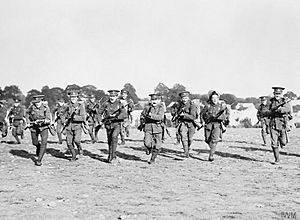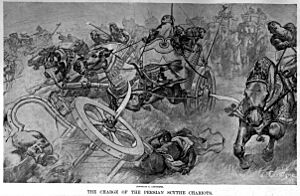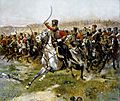Shock tactics facts for kids

Shock tactics are military strategies that aim to scare and confuse an enemy. The goal is to make them panic and break their fighting spirit. These tactics are very old, used throughout history in many wars.
For example, the Mongols became famous for being unbeatable because they used shock tactics. In the Middle Ages, groups of knights on their powerful warhorses would charge together. They would attack enemy soldiers in a way that caused great fear.
A famous general, Robert E. Lee, believed shock attacks were not just about hurting soldiers. He thought they were more about creating panic to "destroy" the enemy army. However, using shock tactics can be risky. The attacking side might also lose many soldiers. For instance, Germany suffered heavy losses using shock attacks in World War I.
Contents
Famous Examples of Shock Tactics
Throughout history, armies have used shock tactics to win battles. They often relied on the psychological impact to defeat their enemies.
Ancient Chariots
The Hittites and Ancient Egyptians were among the first to use a mobile weapon for shock tactics: the war Chariot. Charioteers were the best fighters in most armies of that time. They were fast and could cause chaos.
However, by the start of the classical period, chariots were not as effective. Armies learned how to fight against them. Even the famous scythed chariots used by Darius I of Persia could be defeated by infantry soldiers. Soldiers learned to spread out their phalanx formations. This allowed the chariots to pass through without hitting anyone. The chariots then ran into long pikes held by soldiers behind the phalanx, which stopped them.
Alexander the Great's Cavalry
Philip II of Macedon and his son Alexander the Great often won battles using their special Companion cavalry. These elite horsemen were key to their shock tactics. While the Macedonian phalanx (a formation of soldiers with long spears) fought the enemy head-on, the cavalry waited. Once the phalanx broke the enemy lines, the Companion cavalry would charge. They would act as shock troops, scattering the enemy soldiers and causing them to flee.
German Blitzkrieg
The German Blitzkrieg (meaning "lightning war") was a very effective shock tactic used in World War II. This strategy focused on using fast, powerful forces like tanks, artillery, and airplanes. They would quickly break through enemy lines.
Once the tanks were behind enemy lines, they would cause shock and confusion. They would cut off supply routes and stop enemy reinforcements from arriving. This would trap the enemy troops, forcing them to surrender (military).
Related Military Strategies
- Flanking maneuver
- Pincer movement (also known as a double-envelopment)
- Turning movement
- Ambush
- Envelopment
- Rearguard
- Attrition warfare
- Feigned retreat
- Preemptive war
- Oblique order
Images for kids
-
Attack of the French 4th Hussar Regiment at the Battle of Friedland, 14 June 1807




